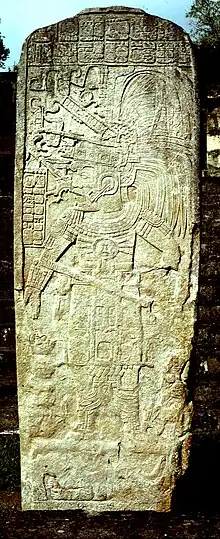كان إيك
كان إيك أو كانيك (بالإسبانية: Canek o Ah Kaan Ek o Kan Ek') هو الاسم المتكرر لزعماء شعب الإيتزا. وظل هذا اللقب لعدة قرون. وفي لغة المايا، يعني كان إك أو الثعبان الأسود.[1]

كان أه كان إيك من ضمن الزعماء الذين أشير إليهم بهذا الاسم وهو الذي استقبل المستكشف الإسباني إرنان كورتيس في تاياسال عام 1525، والذي ترك له المستكشف الإسباني خيله المُصاب في رعايته. فقد كان زعيم الإيتزا والحاكم الأعلى لمنطقة بيتين الوسطى برمتها.[2] وأصبح كان إيك مسئولًا عن هذا الحصان، الذي حينما توفى، أمر بتصنيع تمثال خشبي يماثله.[3]
كان هناك المزيد من القادة الذين اتخذوا اسم كانيك، حتى عام 1697 عندما هزم مارتين دي أورثوا شعب الإيتزا بقيادة أه كان إيك آخر. وعقب هذه الهزيمة، استطاع الإسبان السيطرة على السكان الأصليين في عقر دارهم في بيتين، مُنهيًا بذلك أمر هذه السلالة، التي أعيد ظهورها مرة أخرى مع خاثينتو كانيك في القرن السابع عشر، خلال تمرد ثيستيل.[4]
مصادر
- Todos los soberanos conocidos de los itzaes de Tayasal llevaban el nombre Canek, lo que indica que, más que un nombre creado por la combinación de los de sus progenitores, se trataba del nombre de un linaje o tal vez de un título real. De acuerdo con Avendaño y Loyola , “ viénele este reinado por herencia y así siempre son Ah Canekes sus reyes, mas n o por eso todos los Canekes son de sangre real ni parientes, porque también se llaman Canekes todos los de su pueblo o parcialidad y tienen a más sus apellidos legítimos y sólo tienen ese por la cabeza que los gobierna ” . Así, también fungía como patronímico para los miembros de la cabecera del señor Canek نسخة محفوظة 04 مارس 2016 على موقع واي باك مشين. [وصلة مكسورة]
- Sharer & Traxler 2006, p. 617
- Hernández Sánchez-Barba, Mario (2003) Cartas de relación de Hernán Cortés ISBN 84-492-0352-X Quinta Carta pp.389 .."En este pueblo, digo en aquellas labranzas, quedó un caballo que se hincó un palo por el pie y no pudo andar; me prometió el señor curarlo, no sé lo que hará"
- Casares G. Cantón, Raúl; Duch Colell, Juan; Antochiw Kolpa, Michel; Zavala Vallado, Silvio et ál (1998). Yucatán en el tiempo. Mérida, Yucatán. ISBN 970 9071 04 1
مراجع
- Sharer, Robert J.; Traxler, Loa P. (2006). The Ancient Maya (en inglés) (6.ª edición (completamente revisada)). Stanford, California, EE. UU.: Stanford University Press. ISBN 0-8047-4817-9. OCLC 57577446
- Foias, Antonia E. (2000). J.P. Laporte; H. Escobedo; B. Arroyo; A.C. de Suasnávar, eds. "Entre la política y economía: Resultados preliminares de las primeras temporadas del Proyecto Arqueológico Motul de San José" (PDF). Simposio de Investigaciones Arqueológicas en Guatemala, 1999. Guatemala City, Guatemala: Museo Nacional de Arqueología y Etnología. XIII (1999): 771–799. Retrieved 2012-11-30. (Spanish)
- Foias, Antonia E. (2003). "Perspectivas teóricas en las dinámicas del estado Clásico maya: resultados preliminares del Proyecto Eco-Arqueológico Motul de San José, 1998-2003" (PDF). Mayab (16): 15–32. ISSN 1130-6157. Retrieved 2012-11-30. (Spanish)
- Hofling, Charles Andrew (2009). "The Linguistic Context of the Kowoj". In Prudence M. Rice; Don S. Rice. The Kowoj: identity, migration, and geopolitics in late postclassic Petén, Guatemala. Boulder, Colorado, US: University Press of Colorado. pp. 71–79. ISBN 978-0-87081-930-8. OCLC 225875268.
- Jones, Grant D. (1998). The Conquest of the Last Maya Kingdom. Stanford University Press. ISBN 9780804735223. OCLC 38747674. External link in |title= (help)
- Jones, Grant D. (2000). "The Lowland Maya, from the Conquest to the Present". In Richard E.W. Adams; Murdo J. Macleod. The Cambridge History of the Native Peoples of the Americas, Vol. II: Mesoamerica, part 2. Cambridge, UK: Cambridge University Press. pp. 346–391. ISBN 0-521-65204-9. OCLC 33359444.
- Jones, Grant D. (2009). "The Kowoj in Ethnohistorical Perspective". In Prudence M. Rice; Don S. Rice. The Kowoj: identity, migration, and geopolitics in late postclassic Petén, Guatemala. Boulder, Colorado, US: University Press of Colorado. pp. 55–69. ISBN 978-0-87081-930-8. OCLC 225875268.
- Martin, Simon; Nikolai Grube (2000). Chronicle of the Maya Kings and Queens: Deciphering the Dynasties of the Ancient Maya. London and New York: Thames & Hudson. ISBN 0-500-05103-8. OCLC 47358325.
- Rice, Prudence M. (2009). "The Kowoj in Geopolitical-Ritual Perspective". In Prudence M. Rice; Don S. Rice. The Kowoj: identity, migration, and geopolitics in late postclassic Petén, Guatemala. Boulder, Colorado, US: University Press of Colorado. pp. 21–54. ISBN 978-0-87081-930-8. OCLC 225875268.
- Sharer, Robert J.; Loa P. Traxler (2006). The Ancient Maya (6th (fully revised) ed.). Stanford, California, USA: Stanford University Press. ISBN 0-8047-4817-9. OCLC 57577446.
- Velásquez García, Erik (2007). "La máscara de "rayos X": Historia de un artilugio iconográfico en el arte maya" (PDF). Anales del Instituto de Investigaciones Estéticas. Universidad Nacional Autónoma de México (UNAM) (90): 7–36. ISSN 0185-1276. OCLC 445033034. Retrieved 2010-02-04. (Spanish)
- بوابة المكسيك
- بوابة غواتيمالا